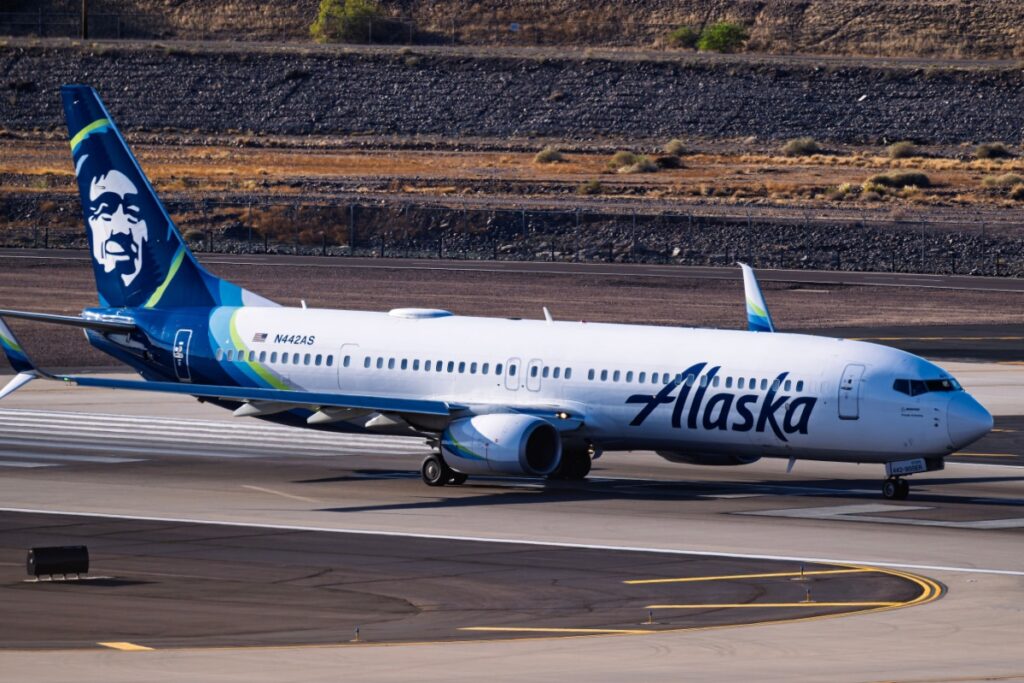Alaska Airlines implemented a nationwide ground stop on Thursday after a major information-technology outage disrupted operations across the United States. The failure, traced to the airline’s primary data centre, halted all departures for several hours and led to widespread cancellations. According to data from FlightAware, more than 360 flights were cancelled by Friday morning, with an additional 400 flights delayed. The disruption extended into regional carrier Horizon Air, which operates under the Alaska brand, affecting flights throughout the West Coast, Alaska, and Hawaii.
Scope of Disruption Across Network
The outage began around 3:30 p.m. Pacific Time, when core scheduling and dispatch systems became unresponsive. The Federal Aviation Administration (FAA) confirmed it had issued a ground stop at the airline’s request as technicians worked to restore internal systems. Affected passengers across major hubs — including Seattle-Tacoma International Airport (SEA), Los Angeles (LAX), and Portland (PDX) — reported long lines and minimal communication as Alaska employees attempted to process flights manually.
Airline Response and Operational Recovery
Alaska Airlines lifted the ground stop at approximately 11:30 p.m. Pacific Time, after partially restoring its flight management system. The airline said in a statement that operations were “gradually returning to normal,” but warned that residual delays and cancellations would continue into the weekend as crews and aircraft were repositioned. The company clarified that the issue stemmed from a data centre hardware malfunction and was not the result of a cybersecurity breach.
Chief Operating Officer Constance von Muehlen expressed apologies to travellers, stating that Alaska’s IT teams were working “around the clock” to stabilize systems. She added that the carrier was implementing an internal review to prevent a recurrence and evaluating potential infrastructure redundancies. The company introduced a flexible rebooking policy, allowing passengers scheduled through October 27 to change or cancel flights without penalties.
Broader Industry Context and Recurring Challenges
The latest failure represents Alaska Airlines’ second major technological disruption in less than four months. A similar system-wide outage in July 2025 temporarily grounded hundreds of flights before normal service resumed. Industry analysts noted that the frequency of IT failures among U.S. carriers — including incidents at Southwest Airlines, Delta Air Lines, and United Airlines — highlights the industry’s dependence on complex, aging digital infrastructure.
Experts in aviation technology have warned that many carriers rely on legacy systems originally designed for far smaller networks. A 2024 report by the U.S. Department of Transportation identified outdated data centres and insufficient redundancy as key operational risks for airlines. The Alaska outage renewed calls for greater investment in cloud-based operations and distributed backup systems to reduce single-point failures.
Financial and Passenger Impact
The financial toll of the outage could reach tens of millions of dollars, according to early estimates by market analysts. On Friday morning, Alaska Air Group’s stock dropped 5.4 % in early trading, reflecting investor concerns over reliability and recovery costs. The airline has not yet released an official cost estimate but confirmed that compensation and refund requests were being processed in line with federal consumer protection standards.
At Seattle-Tacoma International Airport, Alaska’s primary hub, more than half of scheduled flights were cancelled or delayed on Thursday evening. Passengers described chaotic scenes as check-in kiosks failed and boarding processes reverted to manual handling. The Port of Seattle, which operates the airport, stated that operations remained safe but warned of continued crowding due to rebooked travellers.
Other airlines reported only minor knock-on effects, but airport slot management systems and air traffic coordination were briefly disrupted as aircraft movements were rescheduled. Analysts noted that the outage occurred at a particularly sensitive time — during a surge in autumn travel and corporate bookings — likely compounding financial and reputational consequences for the carrier.
Ongoing Restoration and Industry Reaction
By Friday afternoon, Alaska Airlines reported that core scheduling, crew management, and maintenance systems had been fully restored, though some ancillary functions — including mobile app notifications and baggage tracking — remained intermittently unavailable. The company said it had initiated a comprehensive review with its IT partners to determine the cause of the data centre failure and explore preventive safeguards.
Industry observers emphasized that the outage underscores the need for greater digital resilience across U.S. aviation. The Airline Pilots Association and Transportation Workers Union both issued statements urging stronger contingency planning and staff training to manage manual operations during system failures. As of late Friday, Alaska confirmed it expected operations to normalize over the weekend, but acknowledged “continued challenges” as crews and aircraft returned to position.


